Multimodal mobility dashboard - Vancouver region
Region executive summary
This dashboard provides detailed multimodal mobility analyses of four urban highway corridors in the Vancouver region, which includes
- Interstate 5 between the Interstate Bridge and the I-205 interchange
- Interstate 205 between the Glenn Jackson Bridge and the I-5 interchange
- State Route 14 between the I-5 interchange and Camas
- State Route 500 between the I-5 interchange and I-205 interchange
The peak periods for all corridors in the Vancouver region are 6-9 a.m. and 3-6 p.m.
2023 Highlights
- Approximately 758.8 million person miles were traveled on Vancouver region corridors in 2023, up 2.1% from 743.3 million person miles in 2022
- Vehicle delay on the Vancouver region corridors increased 104% from 52,121 hours in 2022 to 106,338 hours in 2023. There was no delay on SR 500.
- Public transportation experienced increases in ridership but remained well below prepandemic levels
- Park and ride lots were also still below 2019 levels in most areas. Park and ride lots on I-5 had an average utilization rate of 9.2%. Lots having 85% or higher utilization rates are considered to be operating at capacity
Source: WSDOT Transportation Safety and Systems Analysis Division and WSDOT TRACFLOW (https://tracflow.wsdot.wa.gov/)
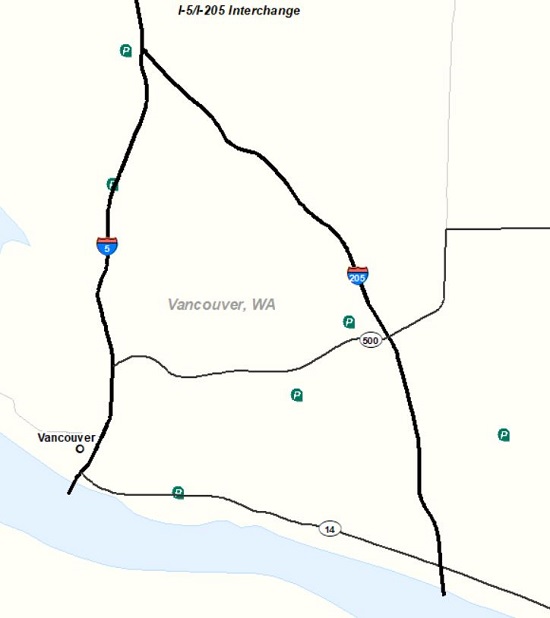
Interstate 5
The Interstate 5 corridor in the Vancouver region runs between the Interstate Bridge over the Columbia River and the I-205 interchange. It is a key commute and economic corridor in the region. WSDOT classifies the I-5 corridor between the Interstate Bridge and the I-205 interchange as a T-1 freight corridor, meaning that trucks carry more than 10 million tons of freight on this corridor annually. The I-5 corridor is served by transit buses and is also paralleled by the Amtrak Cascades passenger rail line. Click the green bar below for more information on Interstate 5 multimodal mobility analysis.
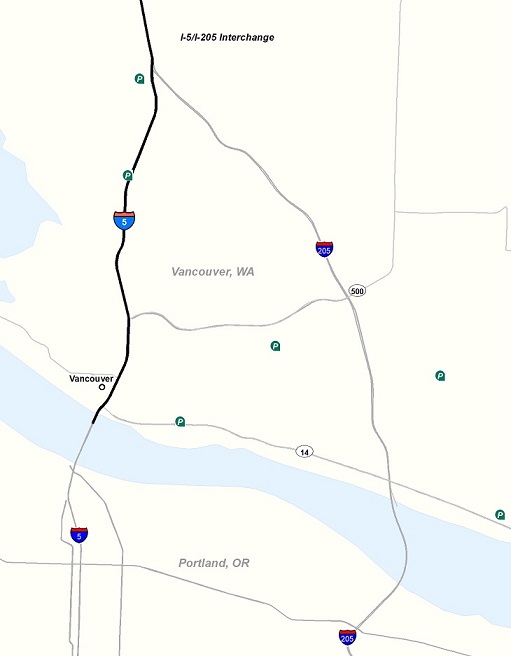
Multi-year trends
General purpose lane person miles traveled and vehicle delay:
- Annual GP person miles traveled decreased by 1.1% from 235.8 million miles in 2019 to 233.3 million miles in 2023
- Annual GP vehicle delay was down 54.8% from 104,400 hours in 2019 to 47,200 hours in 2023
Commute times:
- The eight-mile morning commute during peak times on I-5 from the I-205 interchange to the Interstate bridge (southbound) in the GP lanes took an average of 18 minutes in 2019 compared to 14 minutes in 2023
Delay:
- Annual average daily vehicle hours of delay on southbound I-5 (milepost 1.5) decreased 50.8% in 2023 with 56.8 hours compared to 115.6 hours in 2019
Severe congestion:
- Severe congestion continued to increase in 2023, it was close to pre-pandemic levels. For example, at 6:40 a.m. on I-5 southbound, between the SR 500 interchange and the I-5 bridge, speeds on this commute were below 36 mph, 84.2% of weekdays in 2023 compared to 91.7% in 2019.
Throughput:
- During the morning commute in 2023 throughput productivity improved by 15 percentage points on I-5 near Forth Plain Blvd southbound at 7 a.m., where vehicle throughput was 75% compared to 60% in 2019
Transit:
- In 2023, buses (0.3% of all vehicles) moved 0.3% of travelers compared to 2019, where buses (0.5% of all vehicles) moved 7.7% of travelers during the southbound morning commute on I-5 at the Interstate Bridge
Park and rides:
- In 2023, park and ride lot usage had mixed results compared to 2022 and overall continued to be significantly lower than the pre-pandemic levels. Park and ride usage ranged between 8%-47% in 2023 compared to 50%-98% in 2019
Interstate 205
Interstate 205 is a key commute and economic corridor in the Vancouver region, running from the Glenn Jackson Bridge over the Columbia River to the I-5 interchange. WSDOT classifies this corridor as a T-1 freight corridor, meaning that trucks carry more than 10 million tons of freight on this corridor annually. The I-205 corridor is served by transit buses. Click the green bar below for more information on Interstate 205 multimodal mobility analysis.
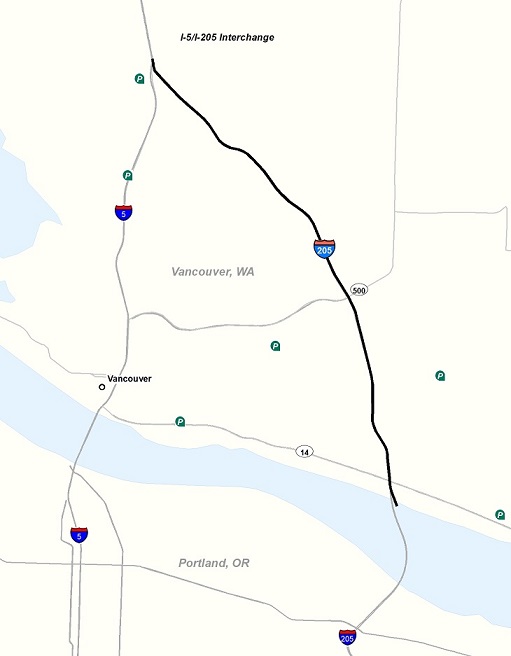
Multi-year trends
General purpose lane person miles traveled and vehicle delay:
- Annual GP person miles traveled decreased by 0.6% from 287.4 million in 2019 to 285.7 million in 2023
- Annual GP vehicle delay was down by 58.8% from 107,300 of vehicle delay in 2019 to 44,200 hours in 2023
Commute times:
- The eight-mile morning commute between the I-5 interchange and the Glenn Jackson Bridge on I-205 took an average of 14 minutes, three minutes less than 17 minutes in 2019
Delay:
- Annual average daily vehicle hours of delay on northbound I-205 around milepost 31.5 increased in 2023 with 43.5 hours compared to 39.4 hours in 2019
Severe congestion:
- Severe congestion continued to increase in 2023, but still significantly lower than the pre-pandemic levels. For example, at 5:20 p.m. speeds from Glenn Jackson Bridge to the SR 500 interchange on I-205 were below 36 mph, 10.5% of weekdays in 2023 down from 22.3% in 2019
Throughput:
- During the morning commute at 8:50 a.m. there was no drop in throughput productivity in 2023 at I-205 near 10th street southbound, compared to 52% in 2019
Transit:
- In 2023, buses (0.2% of all vehicles) moved 0.2% of travelers compared to 2019, where buses (0.3% of all vehicles) moved 5.2% of travelers during the southbound morning commute on I-205 at the Glen Jackson Bridge
State Route 14
State Route 14 runs along the north bank of the Columbia River and is a key commute and economic corridor in the Vancouver region. WSDOT classifies the SR 14 corridor between Camas and the I-5 interchange as a T-1 freight corridor, meaning that trucks carry more than 10 million tons of freight on this corridor annually. The corridor is served by transit buses. Click the green bar below for more information on State Route 14 multimodal mobility analysis.
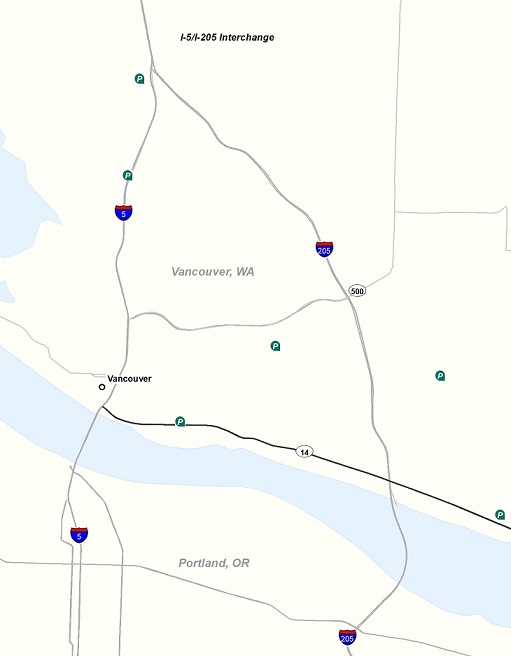
Multi-year trends
General purpose lane person miles traveled and vehicle delay:
- Annual GP person miles traveled decreased by 6.9% from 181.5 million in 2019 to 169.0 million in 2023
- Annual GP vehicle delay was up by 35.1% from 11,100 hours of vehicle delay in 2019 to 15,000 hours in 2023
Commute times:
- Commute times for peak morning and evening commutes continue to increase and some routes exceed pre-pandemic level
- The 7-mile trip from Camas to the I-205 interchange on SR 14 during the peak morning commute in 2023 took an average of 10 minutes—one minute more than in 2019
Delay:
- Annual average daily vehicle delay on westbound SR 14 at milepost 7.5 increased 191.3% in 2023 with 26.8 hours compared to 9.2 hours in 2019
Severe congestion:
- Severe congestion increased in 2023, it is close to pre-pandemic levels For example, at 7:45 a.m. speeds on the trip from Camas to the I-205 interchange on SR 14 were below 36 MPH on 29.4% of weekdays in 2023 up from 13.4% in 2019.
Throughput:
- SR 14 showed eastbound and westbound showed no drop in throughout the day in 2023, compared to 80% in 2019
Transit:
- In 2023, buses (0.1% of all vehicles) moved 0.1% of travelers compared to 2019, where buses (0.4% of all vehicles) moved 6.8% of travelers during the eastbound evening commute on SR 14 at I-205
State Route 500
State Route 500 runs along the north bank of the Columbia River and is a key commute and economic corridor in the Vancouver region. WSDOT classifies the SR 500 corridor between Camas and the I-5 interchange as a T-1 freight corridor, meaning that trucks carry more than 10 million tons of freight on this corridor annually. The corridor is served by transit buses. Click the green bar below for more information on State Route 500 multimodal mobility analysis.
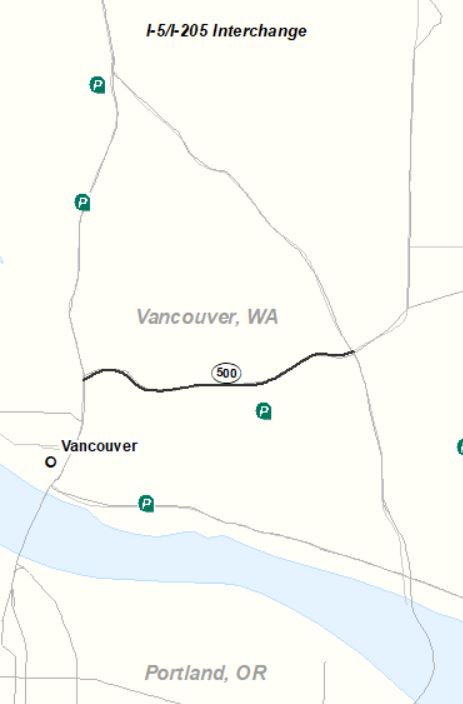
Multi-year trends
General purpose lane person miles traveled and vehicle delay:
- Annual GP person miles traveled decreased by 5.9% from 75.2 million in 2019 to 70.8 million in 2023
- SR 500 experienced no annual GP vehicle delay from 2019 to 2023
Commute times:
- Commute times for peak morning and evening commutes decreased from 2019 to 2023
Delay:
- In 2023, SR 500 experienced no annual average daily vehicle hours of delay
Severe congestion:
- Severe congestion on westbound SR 500 continued to increased in 2023, but was still lower than pre-pandemic levels. For example, at 7:55 a.m. speeds on this commute were below 36 MPH on 0.8% of weekdays in 2023, down from 2.1% in 2019.
Throughput:
- There were no throughput productivity losses on SR 500 between 2019 and 2023
